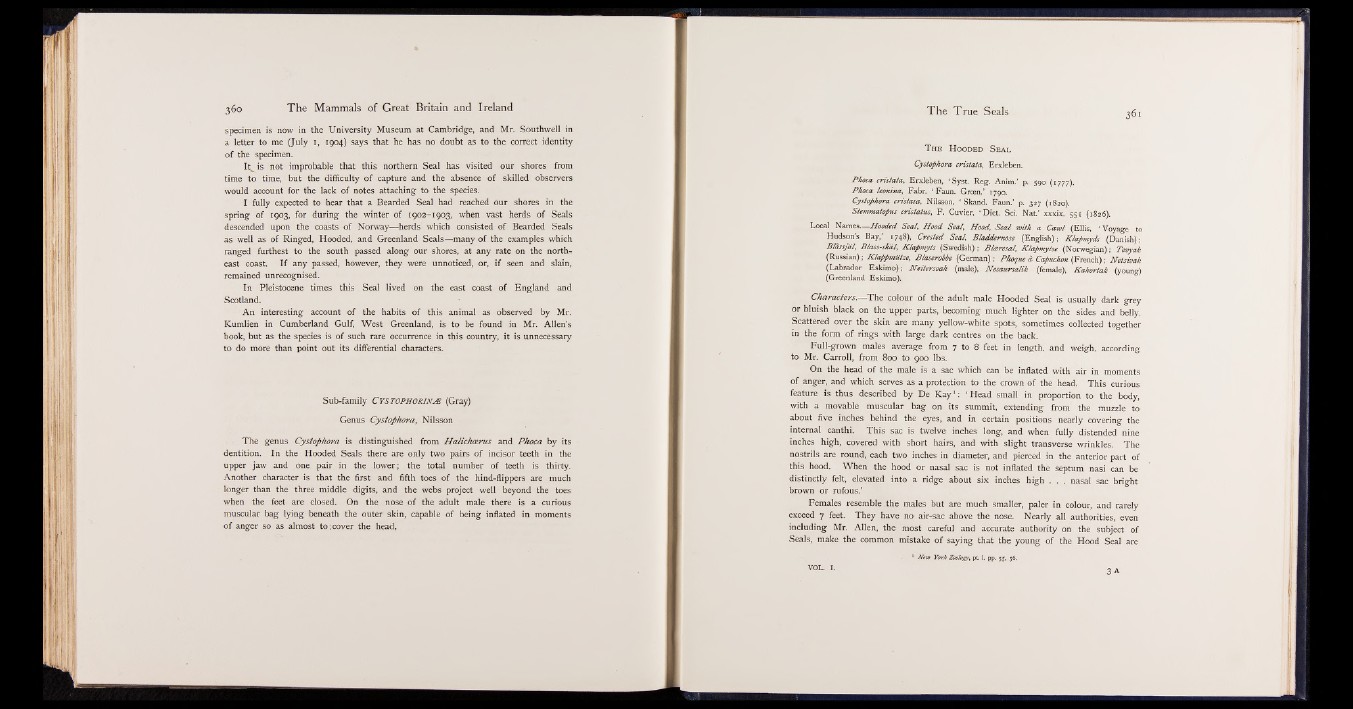
specimen is now in the University Museum at Cambridge, and Mr. Southwell in
a letter to me (July 1, 1904) says that he has no doubt as to the correct identity
of the specimen.
It is not improbable that this northern Seal has visited our shores from
time to time, but the difficulty of capture and the absence of skilled observers
would account for the lack of notes attaching to the species.
I fully expected to hear that a Bearded Seal had reached our shores in the
spring of 1903, for during the winter of 1902-1903, when vast herds of Seals
descended upon the coasts of Norway— herds which consisted of Bearded Seals
as well as of Ringed, Hooded, and Greenland Seals—many of the examples which
ranged furthest to the south passed along our shores, at any rate on the north-:
east coast. If any passed, however, they were unnoticed, or, if seen and slain,
remained unrecognised.
In Pleistocene times this Seal lived on the east coast of England and
Scotland.
An interesting account of the habits of this animal as observed by Mr.
Kumlien in Cumberland Gulf, West Greenland, is to be found in Mr. Allen’s
book, but as the species is of such rare occurrence in this country, it is unnecessary
to do more than point out its differential characters.
Sub-family C Y S T O P H O R IN JB (Gray)
Genus Cystophora, Nilsson
The genus Cystophora is distinguished from Halichcerus and Phoca by its
dentition. In the Hooded Seals there are only two pairs of incisor teeth in the
upper jaw and one pair in the lower; the total number of teeth is thirty.
Another character is that the first and fifth toes of the hind-flippers are much
longer than the three middle digits, and the webs project well beyond the toes
when the feet are closed. On the nose of the adult male there is a curious
muscular bag lying beneath the outer skin, capable of being inflated in moments
of anger so as almost to ; cover the head.
T h e H o o d e d S e a l
Cystophora cristata, Erxleben.
Phoca cristata, Erxleben, ‘ Syst. Reg. Anim.’ p. 590 (1777).
Phoca leonina, Fabr. ‘ Faun. Groen.’ 1790.
Cystophora cristata, Nilsson, ‘ Skand. Faun.’ p. 327 (1820).
Stemmatopus cristatus, F. Cuvier, ‘ Diet. Sei. Nat.’ xxxix. 551 (1826).
Local Names— Hooded Seal, Hood Seal, Hood, Sea l with a Cawl (Ellis, ‘ Voyage to
Hudson’s Bay,’ 1748), Crested Seal, Bladdemose (English); Klapmyds (Danish);
Bl&ssjäl, Blass-skäl, Klapmyts (Swedish) ; Blceresal, Klapmytse (Norwegian); Tevyak
(Russian); Klappmütze, Blaserobbe (German) ; Phoque ct Capuchon (French); Netsivak
(Labrador Eskimo); Neitersoak (male), Nesaursalik (female), Kakortak (young)
(Greenland Eskimo).
Characters. The colour of the adult male Hooded Seal is usually dark grey
or bluish black on the upper parts, becoming much lighter on the sides and belly.
Scattered over the skin are many yellow-white spots, sometimes collected together
in the form of rings with large dark centres on the back.
Full-grown males average from 7 to 8 feet in length, and weigh, according
to Mr. Carroll, from 800 to 900 lbs.
On the head of the male is a sac which can be inflated with air in moments
of anger, and which serves as a protection to the crown of the head, This curious
feature is thus described by De Ka y 1 : ‘ Head small in proportion to the body,
with a movable muscular bag on its summit, extending from the muzzle to
about five inches behind the eyes, and in certain positions nearly covering the
internal canthi. This sac is twelve inches long, and when fully distended nine
inches high, covered with short hairs, and with slight transverse wrinkles. The
nostrils are round, each two inches in diameter, and pierced in the anterior part of
this hood. When the hood or nasal sac is not inflated the septum nasi can be
distinctly felt, elevated into a ridge about six inches high . . . nasal sac bright
brown or rufous.’
Females resemble .the males but are much smaller, paler in colour, and rarely
exceed 7 feet. They have no air-sac above the nose. Nearly all authorities, even
including Mr. Allen, the most careful and accurate authority on the subject of
Seals, make the common mistake of saying that the young of the Hood Seal are
* New York Zoology, pt, 1. pp. 55, 56.
VOL. I. 3 A